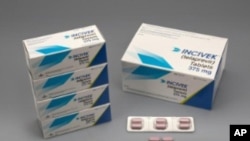The U.S. Food and Drug Administration has approved two new drugs - boceprevir and telaprevir - to treat hepatitis C, a virus that can cause liver damage and cancer. The new drugs are expected to improve cure rates for some of the more than 170 million people worldwide affected by this potentially fatal disease.
Hepatitis C is a blood-borne virus. If blood is not screened for diseases, the virus can be transmitted through transfusions or organ transplants. In the United States, the most common cause of infection is sharing drug-injection needles.
It can take years, or even decades, for the virus to cause enough liver damage to produce symptoms and about three-quarters of Americans with hepatitis C don’t know they have it.
“People got their hepatitis C in the 60s and 70s, and early 80s, and now are having all these problems from it, 20 or 30 years later,” says liver disease specialist Dr. Bruce Bacon of Saint Louis University, adding that about 20 percent of people exposed to hepatitis C recover from the virus on their own, without treatment.
“The flip side of that is about 80 percent of people - 80, 85 percent of people - do get chronic hepatitis. And of those patients, 20 to 30 percent of people develop cirrhosis, and of those, two to three percent of patients develop liver cancer.”
There are six different strains, or genotypes, of hepatitis C. Saint Louis University researcher Dr. Adrian Di Bisceglie says that, in the U.S., about 70 percent of patients have genotype 1, a form of the virus that is also the most common in Latin America, Europe, and parts of Asia.
“And it turns out that genotype 1 is the most hard to treat,” he says.
For the past decade, treatment for hepatitis C has meant a year-long regimen of two drugs: an immune-system booster called pegylated interferon and an antiviral medication known as ribavirin.
But often, Di Besceglie says, that two-drug treatment hasn’t worked for patients with the genotype 1 virus. “In that genotype, only about 40 percent of patients get cured when they’re treated with interferon and ribavirin.”
In a clinical trial funded by the drug maker Vertex, Di Besceglie helped test how hard-to-treat genotype 1 patients responded when a new Vertex drug, telaprevir, was added to the current two-drug treatment.
“The cure rates or the rates of sustained virologic response go from the 40 percent number that I mentioned in patients with genotype 1, to 75 percent.”
A clinical trial for a similar medication, boceprevir, was funded by Merck, the drug’s developer.
Bacon, who led that study, says adding boceprevir to the standard two-drug treatment significantly improved cure rates, even for patients who had been treated before and failed to recover.
“In the treatment-experienced patients, those who hadn’t responded or who had relapsed previously, the numbers are more like 20 percent with the standard therapy being re-treated, versus about 60 to 65 percent cure rate with the addition of boceprevir.”
Dr. Barbara McGovern treats patients with hepatitis C at the Lemuel Shattuck Hospital in Boston. She was on an independent panel of experts that reviewed data on both drugs for the FDA. She says the new drugs do have some side effects - boceprevir can cause anemia, and telaprevir a severe rash - but she believes their benefits outweigh their risks.
“The difference between what you can do with dual therapy and triple therapy is like night and day," says McGovern. “We always have to measure risks and benefits, but the amount of patients who are cured - and that’s a very special word in infectious diseases - is so much higher.”
In the U.S., the current two-drug treatment costs about $20,000. Adding one of the new drugs will likely double or triple that.
Dr. Adrian Di Besceglie says it’s worth it. “You save downstream by saving the costs of caring for patients with decompensated cirrhosis, liver cancer, liver transplantation, all of that. The last few months of life when you have liver failure is terribly, terribly expensive.”
Di Besceglie, Bacon, and McGovern all say there are even better drugs in the pipeline, but those won’t get federal approval for at least three-to-five years. Meanwhile, boceprevir and telaprevir are already on their way to U.S. pharmacies.










